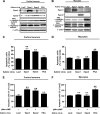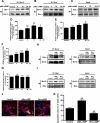Differential roles of Epac in regulating cell death in neuronal and myocardial cells
- PMID: 20516079
- PMCID: PMC2911347
- DOI: 10.1074/jbc.M109.094581
Differential roles of Epac in regulating cell death in neuronal and myocardial cells
Abstract
Cell survival and death play critical roles in tissues composed of post-mitotic cells. Cyclic AMP (cAMP) has been known to exert a distinct effect on cell susceptibility to apoptosis, protecting neuronal cells and deteriorating myocardial cells. These effects are primarily studied using protein kinase A activation. In this study we show the differential roles of Epac, an exchange protein activated by cAMP and a new effector molecule of cAMP signaling, in regulating apoptosis in these cell types. Both stimulation of Epac by 8-p-methoxyphenylthon-2'-O-methyl-cAMP and overexpression of Epac significantly increased DNA fragmentation and TUNEL (terminal deoxynucleotidyltransferase-mediated biotin nick end-labeling)-positive cell counts in mouse cortical neurons but not in cardiac myocytes. In contrast, stimulation of protein kinase A increased apoptosis in cardiac myocytes but not in neuronal cells. In cortical neurons the expression of the Bcl-2 interacting member protein (Bim) was increased by stimulation of Epac at the transcriptional level and was decreased in mice with genetic disruption of Epac1. Epac-induced neuronal apoptosis was attenuated by the silencing of Bim. Furthermore, Epac1 disruption in vivo abolished the 3-nitropropionic acid-induced neuronal apoptosis that occurs in wild-type mice. These results suggest that Epac induces neuron-specific apoptosis through increasing Bim expression. Because the disruption of Epac exerted a protective effect on neuronal apoptosis in vivo, the inhibition of Epac may be a consideration in designing a therapeutic strategy for the treatment of neurodegenerative diseases.
Figures









Similar articles
-
Differential signaling of cyclic AMP: opposing effects of exchange protein directly activated by cyclic AMP and cAMP-dependent protein kinase on protein kinase B activation.J Biol Chem. 2002 Mar 29;277(13):11497-504. doi: 10.1074/jbc.M110856200. Epub 2002 Jan 18. J Biol Chem. 2002. PMID: 11801596
-
Dipeptidyl Peptidase 4 Inhibition Alleviates Shortage of Circulating Glucagon-Like Peptide-1 in Heart Failure and Mitigates Myocardial Remodeling and Apoptosis via the Exchange Protein Directly Activated by Cyclic AMP 1/Ras-Related Protein 1 Axis.Circ Heart Fail. 2016 Jan;9(1):e002081. doi: 10.1161/CIRCHEARTFAILURE.115.002081. Circ Heart Fail. 2016. PMID: 26721911
-
cAMP signalling protects proximal tubular epithelial cells from cisplatin-induced apoptosis via activation of Epac.Br J Pharmacol. 2012 Feb;165(4b):1137-50. doi: 10.1111/j.1476-5381.2011.01594.x. Br J Pharmacol. 2012. PMID: 21745194 Free PMC article.
-
Role of the cAMP-binding protein Epac in cardiovascular physiology and pathophysiology.Pflugers Arch. 2010 Mar;459(4):535-46. doi: 10.1007/s00424-009-0747-y. Epub 2009 Oct 25. Pflugers Arch. 2010. PMID: 19855995 Review.
-
Epac: new emerging cAMP-binding protein.BMB Rep. 2021 Mar;54(3):149-156. doi: 10.5483/BMBRep.2021.54.3.233. BMB Rep. 2021. PMID: 33298248 Free PMC article. Review.
Cited by
-
Putative role of prostaglandin receptor in intracerebral hemorrhage.Front Neurol. 2012 Oct 22;3:145. doi: 10.3389/fneur.2012.00145. eCollection 2012. Front Neurol. 2012. PMID: 23097645 Free PMC article.
-
Epac Function and cAMP Scaffolds in the Heart and Lung.J Cardiovasc Dev Dis. 2018 Feb 3;5(1):9. doi: 10.3390/jcdd5010009. J Cardiovasc Dev Dis. 2018. PMID: 29401660 Free PMC article. Review.
-
Cyclic AMP is both a pro-apoptotic and anti-apoptotic second messenger.Acta Physiol (Oxf). 2012 Feb;204(2):277-87. doi: 10.1111/j.1748-1716.2011.02273.x. Epub 2011 May 26. Acta Physiol (Oxf). 2012. PMID: 21385327 Free PMC article. Review.
-
Cyclic AMP regulates formation of mammary epithelial acini in vitro.Mol Biol Cell. 2012 Aug;23(15):2973-81. doi: 10.1091/mbc.E12-02-0078. Epub 2012 Jun 6. Mol Biol Cell. 2012. PMID: 22675028 Free PMC article.
-
Inhibition of EPAC2 Attenuates Intracerebral Hemorrhage-Induced Secondary Brain Injury via the p38/BIM/Caspase-3 Pathway.J Mol Neurosci. 2019 Mar;67(3):353-363. doi: 10.1007/s12031-018-1215-y. Epub 2019 Jan 3. J Mol Neurosci. 2019. PMID: 30607901
References
-
- Mattson M. P., Kroemer G. (2003) Trends Mol. Med. 9, 196–205 - PubMed
-
- Kobayashi Y., Shinozawa T. (1997) Brain Res. 778, 309–317 - PubMed
-
- Parvathenani L. K., Calandra V., Roberts S. B., Posmantur R. (2000) Neuroreport 11, 2293–2297 - PubMed
-
- Jonakait G. M., Ni L. (2009) Brain Res. 1285, 30–41 - PubMed
Publication types
MeSH terms
Substances
LinkOut - more resources
Full Text Sources
Molecular Biology Databases

